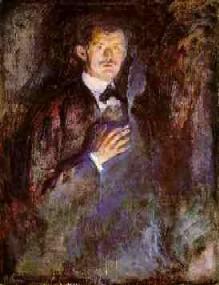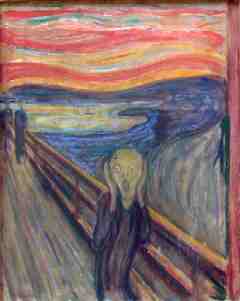» Edvard Munch Biographyby Susan Belmont - February 5, 2004 |
 The painter Edvard Munch was a tormented man, who had a gloomy childhood, but who managed to express all his anguish through his creative and disquieting paintings.
The painter Edvard Munch was a tormented man, who had a gloomy childhood, but who managed to express all his anguish through his creative and disquieting paintings.
He was one of the most important expressionist painters and an inspiration to the modernists of other movements.
Searching For An Invisible Sun
Edvard Munch was born in Løten, Norway, in 1863. His father was a military doctor and his uncle was P.A. Munch, an important historian. His early life was filled with death and illness.
His mother and his 15 years old sister died of tuberculosis when he was 5 years old. A younger sister had a mental illness and the only sibling among the six Munch children who married was his brother Andreas, but who died soon after the wedding. Edvard himself was constantly ill throughout his life.
He studied at the Technical School of Oslo, but at the age of 17 he started to paint, and he took some courses in the Royal School Of Drawing, being most inspired by the French realism.
In 1889, he became acquainted with Hans Jæger, the leader of the Oslo's bohemians. Because of his rigid Christian upbringing, the contact with the anarchist views of Jæger and his friends brought Munch much inner unrest. In that same year, he was awarded a state grant and he went to study in Paris. For the next 20 years he worked mainly in Paris and Berlin.
Shortly after he arrived in Paris, he learned that his father had died and the melancholy shown in his painting "Night" of 1890, is attributed to this sad news.
Much of the subjects of Munch's paintings are based on his suffering, for example the painting "The Scream" of 1893, and the "Sick Child" of 1881-86 reflect his trauma with the losses of his mother and sister, and problems in his sexual life are reflected in paintings like "Vampire".
Talking about "The Scream" picture, it's considered the first expressionist painting and it reflects much of the anxiety and radically changing values of the end of the 19th century.
 Munch's exhibition of his works in Berlin in 1892, gave him notoriety and his works were considered an anarchist provocation by the more traditionalist local painters and it ended up being closed by the authorities.
Munch's exhibition of his works in Berlin in 1892, gave him notoriety and his works were considered an anarchist provocation by the more traditionalist local painters and it ended up being closed by the authorities.
But all this polemic made him more good than bad, and he decided to stay in Berlin among the other artists and intellectuals of the city, which included a great amount of Scandinavians.
In 1896 he got back to Paris. That was when he started to explore the world of lithography and etching, in association with the printer Auguste Clot. He acquired a great dominion of this craft and is considered one of the main graphic artists of his times.
Light In The Darkness
By 1906, Munch was a well-known painter in Europe, respected by artists like Matisse, and had a successful career, but in spite of all, his private life was still a mess. He became an alcoholic and suffered of emotional instability.
One of the main reasons for this, may be a tragic scene that he witnessed, when one of his lovers suicided in front of him with a revolver, which left Munch even more traumatized and with an injured finger on his left hand. The pain of this loss is expressed in the painting "Death of Marat" of 1907.
 In 1908, Munch had a very serious attack of anxiety and had to be hospitalized in Copenhagen. He returned to Norway in 1909, when he was awarded the Order of St. Olav. He settled in the coastal town of Kragerø, and painted several beautiful winter landscapes.
In 1908, Munch had a very serious attack of anxiety and had to be hospitalized in Copenhagen. He returned to Norway in 1909, when he was awarded the Order of St. Olav. He settled in the coastal town of Kragerø, and painted several beautiful winter landscapes.
Through 7 years, from 1909 to 1916, Munch devoted his time to create wall decorations for the auditorium of the University of Oslo, the Aula. When his work was finally finished, it was much criticized, but in the end, it was accepted.
The paintings are fantastic and grandiose, representing the "perpetual forces of life", as he described them, showing fjord and forest landscapes, among other themes.
By the time Munch moved to Ekely, a property near Oslo, he was painting totally different images from his first works. Now his pictures showed harmonious landscapes, people and animals, painted in vivid colours.
He became a hermit in his new home, living in solitude, being most productive, and hardly allowing to be seperated from his works for exhibition.
Shortly before his death, he gave his collection of pictures and writings to Oslo, and in the beginning of 1944, he passed away. In 1963, the Munch Museum was created and it holds the greatest amount of the painter's artworks.
If you want more information:
Edvard Munch - The Dance Of Life Site
*This work's rights belong to the author. No reproduction allowed without the author's consent. If you want to link to this article from your site, please read our privacy policy about it. Thank you!*
::: home ::: visual arts section :::
Copyright © 2003 Susan Belmont